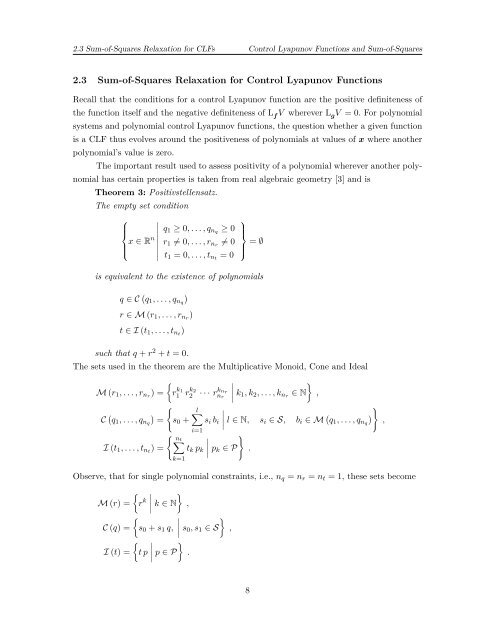Sum-of-Squares Applications in Nonlinear Controller Synthesis
Sum-of-Squares Applications in Nonlinear Controller Synthesis
Sum-of-Squares Applications in Nonlinear Controller Synthesis
- No tags were found...
Create successful ePaper yourself
Turn your PDF publications into a flip-book with our unique Google optimized e-Paper software.
2.3 <strong>Sum</strong>-<strong>of</strong>-<strong>Squares</strong> Relaxation for CLFs Control Lyapunov Functions and <strong>Sum</strong>-<strong>of</strong>-<strong>Squares</strong>2.3 <strong>Sum</strong>-<strong>of</strong>-<strong>Squares</strong> Relaxation for Control Lyapunov FunctionsRecall that the conditions for a control Lyapunov function are the positive def<strong>in</strong>iteness <strong>of</strong>the function itself and the negative def<strong>in</strong>iteness <strong>of</strong> L f V wherever L g V = 0. For polynomialsystems and polynomial control Lyapunov functions, the question whether a given functionis a CLF thus evolves around the positiveness <strong>of</strong> polynomials at values <strong>of</strong> x where anotherpolynomial’s value is zero.The important result used to assess positivity <strong>of</strong> a polynomial wherever another polynomialhas certa<strong>in</strong> properties is taken from real algebraic geometry [3] and isTheorem 3: Positivstellensatz.The empty set condition⎧ ∣ ∣∣∣∣∣∣∣⎪⎨ q 1 ≥ 0, . . . , q nq ≥ 0x ∈ R n r 1 ≠ 0, . . . , r nr ≠ 0⎪⎩t 1 = 0, . . . , t nt = 0⎫⎪⎬= ∅⎪⎭is equivalent to the existence <strong>of</strong> polynomialsq ∈ C ( q 1 , . . . , q nq)r ∈ M (r 1 , . . . , r nr )t ∈ I (t 1 , . . . , t nt )such that q + r 2 + t = 0.The sets used <strong>in</strong> the theorem are the Multiplicative Monoid, Cone and IdealM (r 1 , . . . , r nr ) ={r k 11 rk 22 · · · r knrn r∣ }∣∣∣k 1 , k 2 , . . . , k nr ∈ NC ( ∣)l∑ ∣∣∣q 1 , . . . , q nq ={s 0 + s i b i l ∈ N, s i ∈ S, b i ∈ M ( ) } q 1 , . . . , q nq ,i=1{∑ nt ∣ }∣∣∣I (t 1 , . . . , t nt ) = t k p k p k ∈ P .k=1Observe, that for s<strong>in</strong>gle polynomial constra<strong>in</strong>ts, i.e., n q = n r = n t = 1, these sets become,M (r) =C (q) =I (t) ={ ∣ } ∣∣∣r k k ∈ N{s 0 + s 1 q,{t p,}∣ s 0, s 1 ∈ S}∣ p ∈ P .,8













